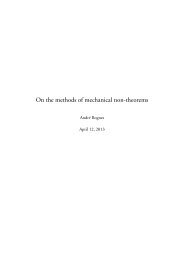The passive voice in written and spoken Scandinavian
The passive voice in written and spoken Scandinavian
The passive voice in written and spoken Scandinavian
You also want an ePaper? Increase the reach of your titles
YUMPU automatically turns print PDFs into web optimized ePapers that Google loves.
2.3 Conditions of use<br />
In the follow<strong>in</strong>g discussion of the use of the <strong>passive</strong> <strong>voice</strong>, the ma<strong>in</strong> focus is on<br />
<strong>written</strong> language. This is because of the nature of the <strong>passive</strong> <strong>voice</strong> research so far, <strong>in</strong><br />
which most of the descriptions <strong>and</strong> discussions are based on examples from <strong>written</strong><br />
sources.<br />
From a language economy po<strong>in</strong>t of view we should expect that the two<br />
Sc<strong>and</strong><strong>in</strong>avian <strong>passive</strong> constructions have a difference <strong>in</strong> mean<strong>in</strong>g or use. Hence, <strong>in</strong><br />
many general descriptions of the <strong>passive</strong> <strong>voice</strong>, we f<strong>in</strong>d the claim that norms, rules,<br />
prescriptions <strong>and</strong> comm<strong>and</strong>s are expressed us<strong>in</strong>g morphological <strong>passive</strong> (e.g.<br />
Western 1921: 161, Diderichsen 1962: 136, Hansen 1967: 147, Thorell 1973: 135).<br />
<strong>The</strong> dist<strong>in</strong>ction between the morphological <strong>and</strong> periphrastic <strong>passive</strong> <strong>voice</strong>s is<br />
<strong>in</strong> addition expla<strong>in</strong>ed as a dist<strong>in</strong>ction between general <strong>and</strong> specific events (Mikkelsen<br />
1975 [1911]: 381, Western 1921: 159–61, Faarlund et al. 1997: 514, Thorell 1973: 135).<br />
Thus, the morphological <strong>passive</strong> is claimed to be used when describ<strong>in</strong>g general<br />
events or ongo<strong>in</strong>g actions, whereas bli-<strong>passive</strong> is used to describe s<strong>in</strong>gle events or<br />
events where the focus lies on the result of the action. As noticed by Engdahl (2006:<br />
25f), this dist<strong>in</strong>ction does not hold for Swedish to the same extent, s<strong>in</strong>ce the<br />
morphological <strong>passive</strong> is used both when talk<strong>in</strong>g about specific <strong>and</strong> general events.<br />
In a recent study of Danish <strong>passive</strong>s, Heltoft & Falster Jakobsen (1996) claim<br />
that the difference between the morphological <strong>and</strong> periphrastic (blive) <strong>passive</strong> <strong>in</strong><br />
Danish is best described <strong>in</strong> relation to the mood system. <strong>The</strong>y argue that the<br />
morphological <strong>passive</strong> expresses objective mood, whereas the periphrastic<br />
construction with the auxiliary blive, ‘become’, expresses subjective mood (Heltoft &<br />
Falster Jakobsen 1996). Example (4a, b), taken from Heltoft & Falster Jakobsen<br />
(1996: 203), illustrates the dist<strong>in</strong>ction:<br />
(4) (a) Indledn<strong>in</strong>gen skrives til sidst. (objective mood,<br />
the.<strong>in</strong>troduction write-S Last norm, general statement)<br />
‘<strong>The</strong> <strong>in</strong>troduction is to be <strong>written</strong> last.’<br />
(b) Indledn<strong>in</strong>gen Bliver skrevet til sidst. (subjective mood)<br />
the.<strong>in</strong>troduction become.PRES <strong>written</strong> last<br />
‘<strong>The</strong> <strong>in</strong>troduction will be <strong>written</strong> last.’<br />
8

















